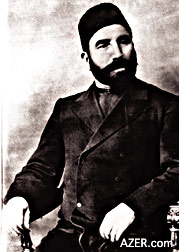|

Summer 2005 (13.2)
Pages
40-43
Institute of Manuscripts
Empress Alexandra Russian Muslim Boarding School for Girls
  Left: Zeynalabdin Taghiyev (1823-1924), known
as the most philanthropic of all Oil Barons, gave this building
as a Girls' School. Left: Zeynalabdin Taghiyev (1823-1924), known
as the most philanthropic of all Oil Barons, gave this building
as a Girls' School.
Location
Street name today: 8 Istiglaliyyat [Independence] Street
Soviet period (1920-1991): Kommunisticheskaya [Communist] Street
Russian Imperial era (before 1918): Nikolayevskaya [Nicholas
II] Street
Personalities
Owner: Zeynalabdin Taghiyev, Oil Baron (1823-1924)
Architect: Joseph Goslavski (Polish, 1865-1904)
Date built: 1898-1901
Use of Building
September 1901until March 1918: Empress Alexandra Russian Muslim
Boarding School for Girls.
December 18,
1918 until April 20, 1920: Taghiyev gave the building to the
Parliament of the first Democratic Republic of Azerbaijan (DRA).
It was the first European-style Parliament in the Muslim world.
The Parliament continued to function until the collapse of the
fledgling republic 23 months later - April 1920 - when the Bolsheviks
invaded Azerbaijan.
Click on
the photos to enlarge.
April 1920 until an unknown date: Bolsheviks turned the building
into the headquarters for the Worker, Peasant and Soldier Deputies.
Also the School for Girls in the building was named after Husein
Javid (depriving the school of its original identity with the
czar's wife). The date must have been only until the early 1930s
since poet and playwright Husein Javid was arrested in 1937 and
branded as an "Enemy of the People" and was exiled
in Siberia where he died in 1944. [Read: "The Night Father
Was Arrested" by Daughter Turan Javid, AI 4.1 (Spring 1996):
Search at AZER.com.]
Unknown date until 1981: Presidium of the Supreme Soviet of Azerbaijan
SSR (Governing Body of the Parliament of the Azerbaijan Soviet
Socialist Republic. Note: We're not sure when this government
body set up their chambers there, but the building was used as
such until 1981).
1981-1986: Manuscript Fund.
1986 to present day: Institute of Manuscripts, which is part
of the Academy of Sciences; also Home Museum of poet and playwright
Husein Javid (1882-1944).
Architectural
Features: The design is based on Moorish architecture, which
was popular in Spain between the 13th to 16th centuries. The
building is characterized by its treatment of windows - the horseshoe-shaped
Moorish arch. The most beautiful gallery is the Institute's main
Exhibition Hall on the second floor. It has elaborate geometric
designs in stucco entirely covering all walls and ceiling. They
are intricately painted in pastels - pink, blue, green and gold.
Historical Background
The building which today houses Azerbaijan's Institute of Manuscripts
was solely designed with education in mind. It was constructed
by Oil Baron Zeynalabdin Taghiyev on the most prestigious street
in town.
Despite never having gone to school himself, nor learned to read
and write, Taghiyev greatly valued education, especially for
girls, which was a revolutionary idea at the time, since it was
a traditional Muslim society. Taghiyev's father had been a boot-maker
and he, himself, had apprenticed as a bricklayer at the age of
six.
Despite what might seem to have been a project worthy of much
praise, Taghiyev had great difficulty in gaining permission to
open the school. He met with vigorous resistance - both from
Russian authorities as well as the Muslim clerics - according
to the late Manaf Suleymanov, who wrote a book in the early 1990s
about the stories and legends that circulated about Taghiyev
during the Soviet period. Alexander who was czar at the time
simply refused to grant permission.
But Taghiyev - who was in his late 70s at the time and who lived
to be 101 years old - would not give up. When Alexander's son,
Nicholas II, came to power, the oil baron sent a very expensive
gift to Nicholas' wife - Alexandra Fyodorovna - imploring her
help. This time he succeeded. In appreciation, Taghiyev named
his school the Empress Alexandra Russian Muslim School for Girls.
To convince the local clergy, Taghiyev sent a trusted colleague
to all the Muslim centers seeking written confirmation from all
major theologists and authorities that the Holy Quran did not
include a single word prohibiting women from getting an education.
The entrepreneur-turned-philanthropist was not be deterred in
his belief that an educated girl would become an educated mother
and, as such, she could better provide her children with a broader
perspective and better life.
Such were the origins that gave birth to a secular, European-style
boarding school for girls - the first of its kind in Baku, and
the first of its kind for Muslims any place in the world.
Construction began in 1898 and was completed in 1901. Building
costs were said to be 184,000 rubles - a considerable sum for
its day. Classes opened on September 7, 1901. The opening ceremony
took place on September 9th. Taghiyev received many congratulatory
telegrams from places like Crimea, Uzbekistan, St. Petersburg
and Kazan. In his opening speech, he conveyed his dream that
"in the future, we must transform this female school into
a gymnasium [high school]."
During that first year, 58 girls were accepted at the school,
35 of whom came from poor families. Taghiyev covered expenses
for school uniforms as well as room and board. To finance the
school, the oil baron invested 125 golden rubles (an inordinate
sum for his time) in the bank as untouchable capital from which
the annual interest provided the budget for the school. He then
set out to hire the best educated women from all over Russia
to staff it.
The school was set up like a restricted boarding school: students
could visit their parents only once a week - on [the holy day
for Muslims] from 10 a.m. to 5 p.m.
Today, the building is still a repository for learning. It houses
the rare Eastern medieval texts of the Institute of Manuscripts
of the Azerbaijan Academy of Sciences. The center collects, systematizes,
stores and publishes analytical works related to these documents.
The collection includes about 40,000 works in various languages
including Azeri, Turkish, Uzbek, Persian and Arabic which provide
rare insight into what scholars from the Middle Ages thought
about medicine, astronomy, mathematics, poetry, philosophy, law,
history and geography. Ironically, most documents are written
in the Arabic script - the official alphabet in Azerbaijan at
the time but which even the benefactor himself was not able to
read.
Access
The Manuscript Institute is not a museum even though it creates
exhibitions for special occasions. Therefore, access is limited.
It is necessary to call at least one day in advance to set up
an appointment to see the main hall. Tel: 492-3197 or 492-1401.
Back to Index AI 13.2 (Summer
2005)
AI Home
| Search | Magazine
Choice
| Topics
| AI Store | Contact us
Other Web sites
created by Azerbaijan International
AZgallery.org | AZERI.org | HAJIBEYOV.com
|









